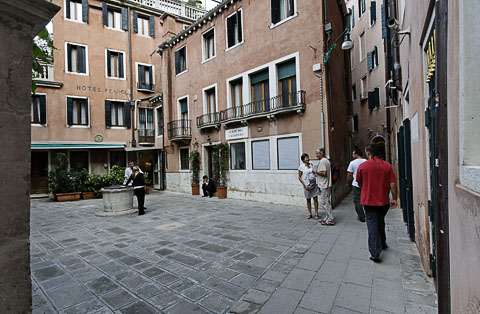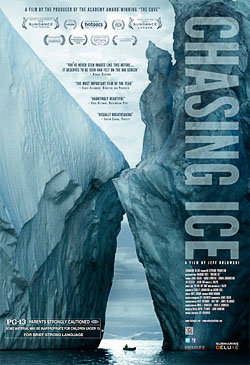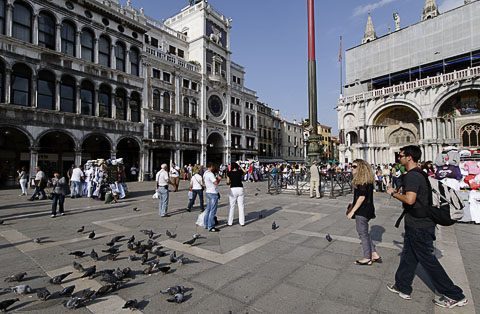
|
||
|
Issue 68 |
|
29 November 2012 |
|
|
|
I still have to tinker with the narration on this one.
|
The BooksCarfree Cities and Carfree Design Manual are widely available in Europe and North America.World Carfree NetworkCarfree.com actively supports World Carfree Network (WCN).World Carfree NewsWorld Carfree News is now available in Czech, English, French, German, Italian, Portuguese, and Spanish. It's published monthly and is a great way to keep abreast of important developments in the carfree cities network. Read the latest issue.
Quote of the Quarter"Discussing energy without talking about climate is like talking about tobacco without talking about cancer."
|
|
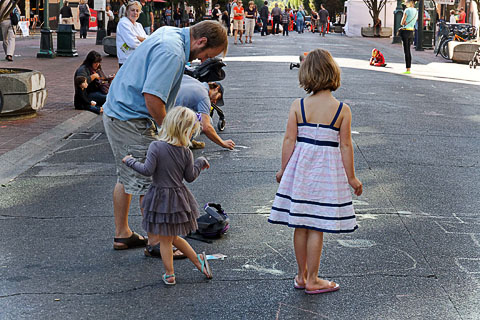 Chalk ©2012 Robin Bassett
Feature ArticleFrom Rickshaw to Car as CulpritChanging Newspaper Coverage of Traffic Congestion in DhakaBy Debra EfroymsonPeople's opinions and views are, to a large extent, shaped by the mass media. The news media, in turn, are owned by giant corporations. So perhaps it should come as no surprise that trying to convince the public of the possibilities and stunning benefits of car-free cities is no easy task: we are up against the monolith of corporate media feeding people with misinformation and cleverly-disguised advertisements for a car-based lifestyle.Giving up is clearly not an option, so what are we to do about the influence of mass media? Is it possible, despite corporate influence, to gain sufficient coverage of our viewpoint to convince people to rethink transport and urban planning? It won't be easy but it is certainly possible. This, at least, is the experience of WBB (Work for a Better Bangladesh) Trust, along with its many allies. They were able to change both the media and political discourse about traffic congestion. When their work started, the media was nearly unilateral in blaming the cycle rickshaw for growing traffic congestion in Bangladesh's capital, Dhaka. With 12-15 million people, an extremely poor bus system, horrid conditions for walking and cycling, and nearly all transport expenditures being aimed at the automobile (which accounts for only about 5% of trips in the city), it should come as no surprise that the city faces intense traffic jams. And perhaps equally unsurprising was the reluctance of anyone to point the blame where it belonged, at the car. But one must blame congestion on something. Given the fact that the rickshaw had no powerful backers, it was an obvious target. Since rickshaws are such a popular mode of transport (among those with no political clout: the middle class and poor), it was no difficult matter to publish photos of streets jammed full of rickshaws. (What the photos fail to show is that a rickshaw jam means virtually no noise and certainly no air pollution. Passengers in different rickshaws can chat with each other. Having sat in many such jams, I am well aware how pleasant they can be!) By blaming the rickshaw and working to ban them from many streets, the government could be seen to be taking serious measures towards alleviating traffic congestion. If the bans spread, rickshaws would cease to be a viable means of transport, so that more of the middle class could be enticed to take out a loan (good business for banks) to buy a car. And the lucrative business of road building could continue apace. In a city where average traffic speed is no greater than the speed of a rickshaw, blaming them for congestion required some creativity. The anti-rickshaw arguments exhibited startling imagination, if little willingness to face reality. For instance, rickshaws were labelled as polluting - because they slowed the cars. And so the executive director of the Dhaka Transport Coordination Board (DTCB) was quoted in one newspaper as saying that "Rickshaws are not an environment-friendly vehicle at all. They create traffic jams that cause vehicles to burn more fuel which in turn greatly increases the pollution levels in the city"; that the job is too difficult for people: "Many consider rickshaw pulling an inhuman profession. Even the communist government of West Bengal in India [banned] rickshaws"; and that "Dhaka is a city where these people can find alternative informal employment." (The Daily Star, 8 September 2003) Officials claimed that rickshaw pedalers debase urban morality, coming as they do from the lower classes (!). And officials used untenable comparisons to claim that rickshaw fares are more expensive than buses or even planes! So the anti-rickshaw media frenzy went on for decades, and various streets were classified as "VIP roads," e.g. no rickshaws. "Time has come to push non-motorised vehicles, in particular rickshaws, to use side lanes of the main roads," argued one transport expert from the World Bank. (The Daily Star, 13 July 2004) "Rickshaws occupy 60 per cent of the road space, which causes congestion," argued the executive director of DTCB. He said that rickshaws, which are responsible for about 60 per cent of the city traffic jam, will be phased out, initially from six major thoroughfares." (The New Age, 16 September 2003) This is a bit like saying that pedestrians block sidewalks and so walking should be banned. The fact that the government's own studies showed no improvement in traffic conditions on VIP roads was unimportant. Nor were the complaints of passengers, particularly women and girls, whose mobility was greatly hampered by the bans. Nor was the intense suffering by the pedalers and their families, whose income fell drastically as a result of the ban (by almost 40% on average). What mattered was the propaganda and the selection of an easy target. Meanwhile, WBB Trust, with technical and financial support from HealthBridge, started working on urban transport in 2004. The original plan was to start by promoting cycling, but given a planned extension of rickshaw bans on an important street, that plan was abandoned and instead WBB launched full-force into recruiting allies and fighting the ban. The fight necessarily had to involve mass media. It was immediately clear just how difficult gaining media support was going to be. Years of anti-rickshaw propaganda had had its desired effect: journalists were convinced that the rickshaws were indeed the source of traffic congestion. Editors and owners were unwilling to publish anything attacking the car and saw no benefit in praising the rickshaw. Fortunately WBB had many years of experience with advocacy campaigns and in working with the media; it also had the optimistic attitude that passivity alone ensures defeat. In addition to trying to train journalists and others about the importance of the rickshaw, WBB needed to convince people that the genuine culprit for the traffic congestion in Dhaka is of course the automobile. The initial campaign to prevent the ban extension on Mirpur Road lasted for a few months; the ongoing work to change media attention and gain policy support for better transport options continues full-force. WBB has a multipronged approach. They recruit allies (transport professionals, journalists, NGO activists, etc.). They organize colourful demonstrations and encourage others to do likewise. They organize seminars, roundtables, and press conferences, with topics including the importance of rickshaws in the transport system and the need for car control and suggested measures. They conduct research, including analysis of existing government statistics and policies. They work closely with HealthBridge to create publications on transport and urban planning issues. They meet one-on-one with journalists and others, and spend hours haranguing journalists over the phone. They write articles and press releases for the major national newspapers. And they use blogs and their website to gain attention to the issue. Carrying on this difficult and frustrating work for eight years would perhaps have proved impossible if not for ongoing signs of success, from the early days onwards. There had always been the occasional pro-rickshaw article or letter in the newspaper, sporadic at best, but those began to increase considerably thanks to the onslaught of information and pushing from WBB and others working on the issue. Most important, not only did more journalists write about the importance of rickshaws (for transport, the environment, and employment) and about the stupidity of the bans, but more editors finally agreed to publish these articles, and articles also began to appear about the role of cars in traffic congestion, serving as they do a very small percentage of trips but occupying a large percentage of road space. For example, former minister and Awami League central leader Mohammad Nasim is quoted in the newspaper as saying that "Rickshaw is the main transport of the middle and lower middle class people. . . Above all, the poor rickshawpullers too will have an opportunity to earn some money." (Tawfique Ali, "Take a breath, ride a rickshaw: Environment friendly three wheelers dominated city streets during siege yesterday," The Daily Star, 13 November 2006) And Guang Chen, a transport specialist at the World Bank, was quoted in New Age Metro on 11 February 2005 as saying that "Only the rich people gain benefit from ban on the rickshaws." Over the years, newspaper coverage also broadened in scope and depth. Transport no longer meant just the car; the problems faced by pedestrians and cyclists, and the need to restrict car ownership and use, all became topics in the newspaper. Although the government is still reluctant to carry out any genuine measures for car control, the fact that the subject is no longer taboo represents an enormous victory: "We shall have to devise a mechanism so that people are discouraged to use private car and encouraged to use public transport," said Sharif Mohammad Tariquzzaman, representative of Urban Development Directorate. ("Parking guideline needed to ease traffic congestion." The Daily Star, 17 November 2008) Key approaches to the success of WBB and its allies in changing, at least to some degree, newspaper and political discourse on traffic congestion include building relationships with journalists, NGOs, transport experts, and others; engaging in a multipronged approach (demonstrations, seminars, research, publications, meetings, press releases, articles, letters, talking to journalists, maintaining a blog, etc.); relying on experts to fill in information gaps rather than trying to become experts on all relevant aspects of urban and transport planning; making strategic use of allies; and refusing to believe in the possibility (or likelihood!) of defeat. Other key qualities that helped increase the chance of success included persistence, perseverance, patience, and creativity. Without a good deal of patience and the ability to continue trying despite difficulties and failures, there is no hope for success.
Debra Efroymson is a regular contributor to
Carfree Times and Sustainable City News. She splits her time between Dhaka and Colombo, working on Liveable Cities for the Canadian public-health NGO HealthBridge.
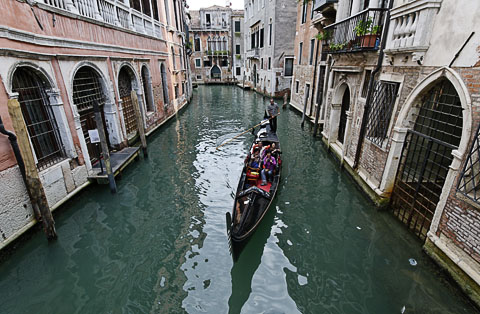 Venice 2012 J.H. Crawford Feature ArticleVenice Is Dead. . . NearlyBy J.H. CrawfordVenice is losing its magic, at least for me. All of the things that once made it such an extraordinary place are still there, but they are watered down.When Carfree Cities was published in 2000, the city's permanent population was about 70,000. It has continued a long, slow decline and has now fallen to about 58,000. This is due in part to the very high short-term rental rates for private apartments; a typical family can move to the mainland and live on the rents from their apartment. In the late 1990s, the number of visitors to Venice was 12 million a year. My hotel manager on this trip told me that it has since risen to 22 million. The city is preparing for 50 million, which seems absurd to me. The number of daily visitors today is about equal to the permanent population. The city certainly feels much more crowded than when I first visited in 1991. Pedestrian traffic jams are now common in certain places in the afternoon, before the day-trippers begin to leave. Part of the problem is the cruise-ship trade. The very largest ships now call routinely at Venice and disgorge huge numbers of passengers for half a day. These folks seem to regard Venice as a great shopping experience and little more. They have no idea how pedestrians should behave in Venice, with the result that they behave badly. (It only takes a day or two to understand the unwritten rules.) The blather from mobile phones now overwhelms the quiet of the streets. Add to this the roar from the ever-more-common large watercraft and the enormous numbers of water taxis, which seen from the air now carve a continuous trail of wakes along the principal waterways. The wonderful peace and quiet of the city seem gone in many places during much of the day. The people who wait on you in the hotels and restaurants were, 20 years ago, nearly all Venetians, bursting with pride about their city. They would take any opportunity to extoll the virtues of Venice. Today, most of the service people are not Venetian, and a great many are not even from Italy. While they are generally nice folks, they lack the sense of the city's exceptionalism and remain largely unaware of its long and remarkable history. This is a subtle but important decline in the quality of Venice as experienced by visitors. However, authentic Venetian life can still be experienced in the quarters off the beaten tourist track, and it is this life that will be the subject of some forthcoming videos. I regard the most important benefit of carfree cities as being the vast improvement in the quality of public social spaces that it nearly always engenders. This will continue to be a theme in all my work. I had a strong feeling this trip that Venice is now regarded by most Venetians as not much more than the goose that lays precious glass eggs every day. Water taxis ignore speed limits with impunity, so the city's foundations are being attacked by wakes at a rate never seen before. I have a sense the people feel the city is doomed by the many pressures on it (not least of which is the increasing frequency and depth of flooding), so the only thing to do is to extract as much money as possible from the city before the end. The enormous pride of the Venetians in their extraordinary city seems on the wane. So, no, Venice is not dead. Try to visit soon, and plan to stay for at least a few days. The experience is already tarnished, and it's probably going to get worse, unless the city bans (somehow) day-trippers and cruise-line passengers. These measures are actually under discussion, but nobody seems to think they will be implemented.
J.H. Crawford is editor and publisher of Carfree Times
and author of two books on carfree cities.
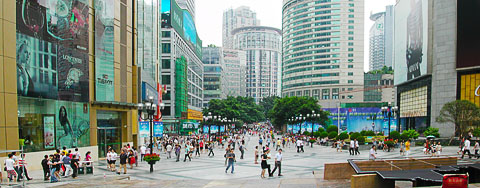 Chongqing, China ©2012 Fanis Grammenos News BitsThe links below will open in a new browser window (crtl + left-click to open in a new tab instead):
"Iskandar Malaysia - the green mega-city rising above Singapore"
"Chengdu Tianfu District Great City, China" See also: "A City Where Everything Is a 15 Minute Walk Away"
"Cardiff councillor Ralph Cook urges 'car-free' suburb"
"Europe's Vibrant New Low Car(bon) Communities" [PDF!]
"Grand plans: how the simple planning diagram has shaped our cities"
"A Chinese City Moves to Limit New Cars"
"Why Delhi has again become submerged by smog"
"The 'European Citizens' Initiative' in a Nutshell"
"Cargo cyclists replace truck drivers on European city streets"
"Stand Still for the Apocalypse"
"Does Arctic Amplification Fuel Extreme Weather in Mid-Latitudes?" [Video!]
"Antarctica: A Greenhouse Gas Hotspot?"
"Saving the Arctic Ice: Greenpeace, Greenwashing and Geoengineering"
"Larry Summers: It’s time to tax carbon and treats"
"Cut the power of fossil fuel"
"Peak cheap oil is an incontrovertible fact"
"US can become world's biggest oil producer in a decade, says IEA"
"Study: Extreme Weather Hammers Global Food System: Current and future impact of floods and droughts being underestimated, says Oxfam"
"Food Crisis Looms, UN Agencies Urge Action to Avoid 'Catastrophe'"
"Manifesto for a Post-Growth Economy: What single change stands to give Americans more free time, healthier ecosystems, and more meaningful jobs?"
Film
I watched this film shortly before going to hear Bill McKibben speak, and it was an appropriate juxtaposition. The film chronicles the efforts of photographer James Balog to shoot years-long time-lapse sequences of glaciers in the Northern Hemisphere. There are some technical details of the process that I found interesting and that most people probably will not. That is the only significant flaw in the film. I watched it with a curious mental conflict. On the one hand, the photographs are themselves often stunningly beautiful, and some of the sequences of enormous icebergs calving are frightful; the scale is gigantic beyond my experience with anything except mountains and the sea itself. At the same time, the beauty of the ice is sinister in its rapid disappearance. I left this film with a sense of things being out of joint. They are. The following synopsis is from the film's web site: In the spring of 2005, acclaimed environmental photographer James Balog headed to the Arctic on a tricky assignment for National Geographic: to capture images to help tell the story of the Earth’s changing climate. Even with a scientific upbringing, Balog had been a skeptic about climate change. But that first trip north opened his eyes to the biggest story in human history and sparked a challenge within him that would put his career and his very well-being at risk. Chasing Ice is the story of one man’s mission to change the tide of history by gathering undeniable evidence of our changing planet. Within months of that first trip to Iceland, the photographer conceived the boldest expedition of his life: The Extreme Ice Survey. With a band of young adventurers in tow, Balog began deploying revolutionary time-lapse cameras across the brutal Arctic to capture a multi-year record of the world’s changing glaciers. As the debate polarizes America and the intensity of natural disasters ramps up globally, Balog finds himself at the end of his tether. Battling untested technology in subzero conditions, he comes face to face with his own mortality. It takes years for Balog to see the fruits of his labor. His hauntingly beautiful videos compress years into seconds and capture ancient mountains of ice in motion as they disappear at a breathtaking rate. Chasing Ice depicts a photographer trying to deliver evidence and hope to our carbon-powered planet. Go see it, even if you're already convinced about climate change.
Back to Carfree.com
E-mail
|
